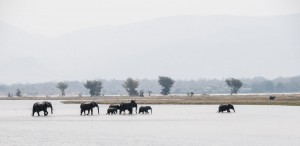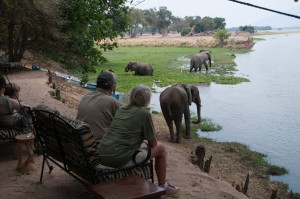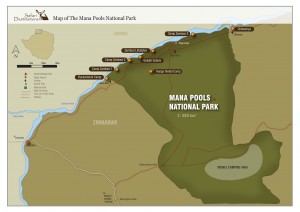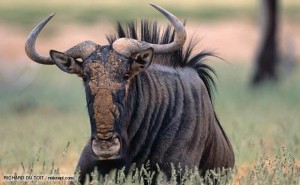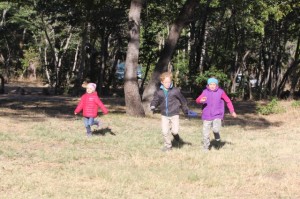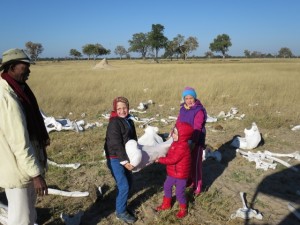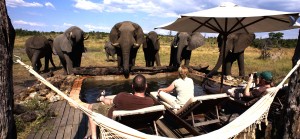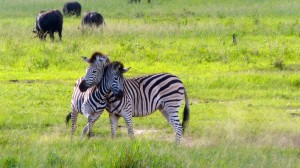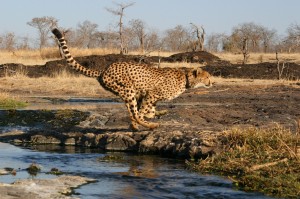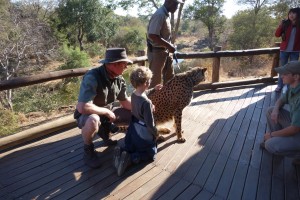Mana Pools – Africa’s forgotten Paradise
I have always been in love with Mana Pools.
Mana is my mentor – a remote and wild park that feeds my soul with all her sights & sounds – I’ve visited her time and again in her different seasons. Her moods are many and despite the diverse ecology and terrain, each one of these trips has been memorable for one thing. I’ve had some of the best close-up game encounters ever! Sitting under the watchful eye of a professional guide meters away from lion, wild dogs, the legendary standing bulls of Mana and a myriad of plains game and birdlife is just one way in which this park immerses you and brings you back to the fundamental core of nature and our place in it. 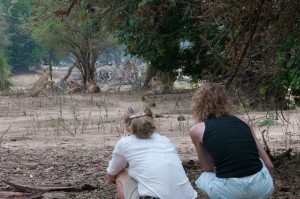
Your clock adjusts to sunrise and sunset and you fall into beat with the natural order of things, according to the rhythm of nature and camp life – the game is clearly abundant in peak season and our recent visit took us to just a few of the camps that have the privilege of operating in and being the custodians of this special park:
Chikwenya, Vundu, Little Vundu, Camp Zambezi and Zambezi Lifestyles as well as Goliath Safaris (I had stayed at Kanga and Rukomechi on my last trip).
Zambezi Lifestyles – *top spot – really enjoyed being right on the flood plain (Ngundu 2 site), saw game all over the place (NOTE the camp moves between different sites depending on which is available, all are on the river) enjoyed the simple comfort of the tents and space of the camp – 4 tents set up boasting the new flush toilets in the open air bathrooms – great bucket shower – excellent local staff managing camp (Cloud was a treat to be in camp and on safari with, very passionate, knowledgeable and eloquent, we also did our canoe trip with him, we weren’t just ‘guided’, we were educated too) – tents/hardware were all solid – food was amazing (I made a point of going to meet the cook, these bush cooks really are talented is all I can say!) – Highlight: herd of 400+ buffalo and sitting on the vehicle near Zebra Vlei watching a pack of 7 adult wild dogs with pups in the late afternoon, they went off on the hunt as the sun went down.
Goliath Tented Camp – *top spot – also really enjoyed being in this camp (I rate both Zambezy Lifestyles and Goliath as my trip highlights) – Camp is on a private concession so in the same location annually. Owner and Pro-Guide in camp is Stretch (Andrew) Ferreira, he is running the camp – the location is stunning with shade over the central areas looking out onto a channel and island just in front of camp, beyond the island is the main river. The first thing you feel here is welcome and are encouraged to feel right at home and ‘part of the family’ – camp layout is neat and functional with a super river front lounge/dining/breakfast/fire pit areas, the tents are set slightly back – the extended size east African tents are very nicely fitted with tasteful teak and wrought iron furnishings, the beds are very comfortable and I loved the open air shower area – vehicles are open top and in good condition – food was awesome! Highlight: pride of 5 lions right outside camp having a snack out of the cooks cell phone, about 15m from us.
If you are a safari addict and look for close wildlife encounters with excellent guides – then Mana Pools should be your next destination! Our recommendation for an intense safari experience is the 10 night itinerary “Spezialised Guides of Zimbabwe” with:
| 3 Nights Goliath Safaris Tented Camp, Mana Pools Natonal Park | |
| 3 Nights Musango Safari Camp, Matusadona National Park | |
| 3 Nights Camp Hwange, Hwange National Park | |
| 1 Night The Elephant Camp, Victoria Falls |
Have you ever heard of the GRUFFALO?
Last year Lorraine and I started a tradition of our two families going on safari together. This year our annual family safari took us to Hwange. Travelling with kids is an adventure. Seeing nature through their eyes makes you realize how wonderful our planet really is. Did you know that a wildebeest looks a bit like a Gruffalo. For all ignorant people out there, “The Gruffalo” is one of the best-loved children’s books ever. “A gruffalo? What’s a gruffalo?”
“A gruffalo! Why, didn’t you know? He has terrible tusks, and terrible claws, and terrible teeth in his terrible jaws.”
And so begins the story of a quick-witted mouse as he encounters a host of predators who seem to think he might make a tasty treat. As he ventures deeper into the deep dark wood, stumbling across a hungry fox, a not-so-wise owl, and a slimy snake, spinning ever-extraordinary yarns about the scary, scaly gruffalo, he quickly realises that the hungry beast he has been talking of isn’t imaginary after all.
On Safari with the Gruffalo:
Three bush babies strolled through the Hwange vlei,
they saw some Lions lying in their way,
snoozing and dreaming of roasted Gruffalo on a spit,
the Bush Babies turned around and away they slid…
Our days in Hwange were filled with extraordinary gamedrives. Living in Botswana also means that our children grow up being spoilt safari-goers, but Hwange can easily compete. Especially the south-east of Hwange offered outstanding game viewing (Davisons, Bomani, Camelthorn and Little Makalolo). It never got boring, the kids loved every moment of it. Hwange in combination with Victoria Falls and Chobe is a great destination for a family safari!
Hightailing it to Hwange
“Come quietly and sit down’ our guide Nick said, moving over to the dinner table laid out by Somalisa Camp’s small pool. Kay and I negotiated the steps down to the deck carefully by the dim light of hurricane lanterns, trying not to fall on our faces or make any sudden movements. We were sitting down to dinner with an unusual guest, a big elephant bull who had come to drink out of the pool, trying his best to drain the water dry. He faced us head-on, something that would make you twitch in the bush, especially as he was only four metres away. He disregarded us, plunged his trunk into the water, slurped up the liquid and threw it down his throat. The noise was incredible. “It sounds like a really big toilet flushing” said Johnny, our host and camp manager. “They don’t drink out of the waterhole?” Kay asked. “They like the clean water,’ said Nick ‘they prefer the waterhole for mud baths.”
As we chatted over starters and broke bread, the bull moved off and another came to drink, then another. Somewhere through the main course, a breeding herd gathered around opposite us, with a very small elephant calf. We gawked at the noise of 10 toilets flushing in succession as the little calf tried to find water with its trunk. “It’s amazing how blasé you get’ said Kay ‘we’re just sitting here, having dinner and a chat.” She was right. If one of the bulls didn’t like us, it wouldn’t have taken much for him to do something about it from the other side of the pool, but they were calm and Nick was used to this behaviour. It had almost become Somalisa Camp’s guaranteed dinner-time entertainment.
Kay & I had come to Hwange during green season, a time when game viewing is far more challenging and so we were expecting game sightings to be few and far between. Luck was on side, however and on the first morning game drive into Hwange National Park we found a pack of twelve wild dogs moving along the roadside, sniffing bushes and trying to pick up the scent of something to chase for breakfast. We followed them for at least ten minutes as they scoured both sides of the road for a scent before disappearing into the thick brush. Later that day, driving with Nick from Hwange Main Camp we spotted huge amounts of plains game, zebra taking dust baths in the afternoon light, big herds of buffalo spread out across the plains and a big sable bull whose elongated horns curved all the way back to his shoulders.
As the sky started turning orange and pink just before sundowners, we found two big male lions and three lionesses stretched out over termite mounds with full, round bellies and a buffalo kill hidden in the bushes. “It’s interesting about these male lions’ Nick said ‘this one, Cecil with the big black mane is about eleven years old. One of the lion researchers around here thinks he has the biggest skull on record. He got kicked out of his territory by a younger male and was living on the periphery for ages. Then he teamed up with this other male Jericho who’s now nine and they took this area off a younger lion. It’s not often you see that. Normally once they get kicked out, they’re out. And now they have these three young girls here. They can’t be older than five. They’re all quite full with buffalo, but it looks as if one of them might be pregnant.”
The next morning the lions were still right where we left them and had begun slinking over to a nearby waterhole to drink. In the background a black-backed jackal was chewing pieces of meat off an elephant carcass as the vultures watched. We moved over to another waterhole and Nick was distracted by movement on the water. “What’s going on here?’ he said ‘I’ve never seen this before.” Sitting on the water were two Egyptian geese, determined to drown another goose by swooping on his head and forcing him underwater. The goose would then swim under water and pop up about ten metres away as his bullies scanned the water looking for him. As soon as he surfaced, the two geese would be on him again in a blaze of feathers and fury. We watched the attack, holding our breath as each attempted drowning was followed by an underwater swim and a quick breath of air before the geese were back on the trail. Suddenly it seemed a lifetime since we’d seen our half-drowned goose. We checked the surface of the water, scanning for a sign of life. Nothing. More time passed and we started to believe the goose had drowned as the other two geese started honking out cackles and flapping their wings in victory. Just as we started lamenting the goose’s demise, a little figure popped up on the side of the waterhole. He’d swam at least thirty metres underwater in a final attempt at escape. He was soggy, but undetected and alive.
We headed back to Somalisa Camp to pack our bags and move on to another part of Hwange. As we wandered around the main camp gossiping about the morning’s sightings, I was distracted by movement out the corner of my eye. Across the plain near the tree line, impala were scattering. I pointed and yelled gibberish, trying to get everyone’s attention while trying to figure out what I was seeing. “Um, lion…” I shouted on impulse, watching something straw-coloured fifty metres away chasing the antelope. “No, cheetah!” said Nick as we watched the chase becoming un-successful, the impala running faster as the cheetah slowed, panting with fatigue. Nick ran for the vehicle and brought it around as the cheetah retreated to the tree line. We were going to try and catch up with her in our last ten minutes in camp. We drove the tracks and scanned the grass. We knew the cheetah had been right where we were only moments ago. We drove forward & back, looking for leaves or grasses moving. “At this time of year, all she has to do is lie down and you’d never know she was here” said Kay. True enough, she’d disappeared for good, probably hiding no more than twenty metres from us, but in the thick shrub, we didn’t have a chance. This was why searching for game in green season held an exciting element of the unknown. You just never knew what was hiding in the long grass.
Getting to Hwange
Hwange is surprisingly close to Victoria Falls and accessible by tar all the way up to Hwange Main Camp. Road transfers from Victoria Falls town will get you to the lodges on their own private concessions bordering the park in approximately 2 ½ hrs. Flights from Victoria Falls will get you to camps within the park in 45 – 55 minutes. Due to Hwange’s close proximity to Victoria Falls, the park is a logical extension to any Botswana itinerary finishing in Victoria Falls and can be very cost-effective as compared to a delta fly-in.
Where to visit in Hwange
Like the parks in Botswana, there are no fences around Hwange National Park, meaning game can move freely between the park and the lodges on small private concessions outside the park. The terrain in the north of the park around Sinamatella features a lot of hills, granite kopjes and deep valleys, whereas Hwange Main Camp is characterised by open grassland surrounded by acacia woodland. The landscape further south towards the Linkwasha concession changes again, with more Molokwane Palm trees and open pans. The diversity of the park makes it easy to combine two separate camps in two separate areas and achieve a varied safari experience.
Lodges/Camps outside Hwange: While these properties are not technically in the park, they experience good numbers of game moving through in the dry season and some have very productive waterholes and resident populations of game that can be reliably sighted. Most of the camps offer game drives on their own private concessions with the option to game drive inside Hwange National Park as well. We recommend pre-paying park fees to provide clients with the option of both.
Camps inside Hwange: Staying inside the park provides a more intense bush experience and removes the necessity of checking in at park gates before and after game drives. The camps inside Hwange National Park have small private concessions around them, enabling more relaxed sundowners without a rush back to camp before park closing times. Some of these camps can also offer short night drives, something which is not permitted inside national parks in Botswana.
What to combine it with: Hwange is very much a dry land game viewing destination. The park roads are easy-going and very well sign-posted making it a great introduction to a safari before continuing to Botswana. Hwange National Park works very well combined with a houseboat experience or Chobe Savanna Lodge in the Caprivi (opposite Chobe National Park) for a dry land and water contrast before continuing to the dry land game viewing of the Khwai Community Area or Moremi Game Reserve.
Pre-Packaged Options: Check out our 8 Night Elephant Paths itineraries combining Hwange, Victoria Falls and Chobe or extend to a 10 Night Elephant Paths package with a fly-in to the Okavango Delta. All packages can be downloaded from our Agent’s Corner.
Sylvester – the cheetah ambassador
Last weekend we spent a few days in Vic Falls and were excited to meet the famous cheetah Sylvester, who lives in the private concession of “The Elephant Camp” a few kilometers outside of Victoria Falls in Zimbabwe.
Here is his story:
In April 2010, in the Lowveld area of Zimbabwe, a cheetah gave birth to five cubs. Sadly within two days, in a cruel act of nature, she and four of her cubs were fatally attacked by a male lion, something which is common between apex predators in the wild. The sole survivor was discovered by a game scout named Sylvester, who witnessed the event and the cub was named after him by Norman and Penny English who became his surrogate parents. Norman worked in National Parks and Wildlife Management for many years and now heads the anti poaching unit in the Bubi Conservancy. Penny is a registered nurse and having both their experience was invaluable in the attempt to keep this young cheetah alive. At two days old, Sylvester still had his umbilical cord attached and unopened eyes.
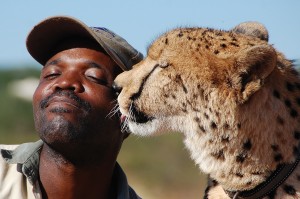
Sylvester is an orphaned cheetah who found a home in the private concession of The Elephant Camp in Victoria Falls, Zimbabwe
Over the following six months the hard work and devotion from the English
family was rewarded but it did not come easily. Feeding was complicated and
Sylvester grew faster than his bones could grow but the struggle to find a
suitable formula was assisted by the many cheetah experts who passed on
information. In time a dietary plan that suited Sylvester was formulated and
he began to respond.
As Sylvester was never destined to become a pet, and being a specially
protected animal on the endangered species list, the Department of National
Parks and Wildlife Management have naturally been involved from the outset
with Sylvester’s welfare. A plan needed to be formulated for a future
permanent home for Sylvester, and in this regard VFWT became involved. Despite numerous release attempts, cheetah, apparently, do not survive in the wild without experiencing the maternal care of a mother for the initial twenty two months of their lives. The human imprints of upbringing in captivity are not conducive to a wild release with rehabilitated cheetah often coming into contact with human settlements and being seen as “problem” animals.
The Sanctuary that Vic Falls Wildlife Trust operates from has large areas of
open grasslands where a cheetah can exercise naturally and build up the
speed for which they are renowned. With no large predators around and the
support from his three carers who exercise him extensively and assist in
nurturing this orphan, Sylvester has settled in to his new life with
vigour. Through our educational programme, Sylvester interacts with
schoolchildren and guests who visit the Elephant Wallow during other
activities. He will become an “ambassador” cheetah, interacting with the
public to raise awareness of their peril as a species and the challenges
they face being on the endangered species list.
Here in the Victoria Falls region, cheetah are a rare sighting and whilst
VFWT respects that the ultimate aim is to promote the conservation of
wildlife and are merely custodians of this magnificent animal, funds need to
be raised for his upkeep. With feeding, exercise, care and constant
companionship, Sylvester has already adapted perfectly to his new
environment.
Guests at The Elephant Camp have the unique opportunity to experience Sylvester, learn about his endangered species and can support this good cause.
We at Safari Destinations would like to raise awareness for this very important project.
Find out more about Sylvester the cheetah on Facebook: http://www.facebook.com/pages/Sylvester-Cheetah-Ambassador/169927003078626
- « Previous
- 1
- 2
